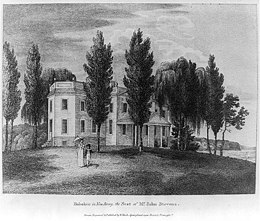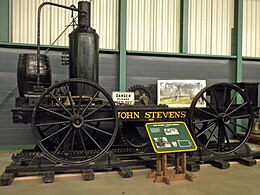John Stevens (inventor, born 1749)
John Stevens | |
|---|---|
 | |
| Treasurer of New Jersey | |
| In office 1776–1779 | |
| Personal details | |
| Born | June 24, 1749 New York City, Province of New York, British America |
| Died | March 6, 1838 (aged 88) Hoboken, New Jersey, U.S. |
| Spouse |
Rachel Cox (m. 1782) |
| Relations | See Stevens family |
| Children | 13, including John, Robert, Edwin |
| Parent(s) | John Stevens Elizabeth Alexander |
| Residence | Castle Point |
| Alma mater | Kings College |
| Military service | |
| Allegiance | United States |
| Branch/service | Continental Army |
| Rank | Colonel |
| Battles/wars | Revolutionary War |


Col. John Stevens, III (June 26, 1749 – March 6, 1838) was an American lawyer, engineer, and inventor who constructed the first U.S. steam locomotive, first steam-powered ferry, and first U.S. commercial ferry service from his estate in Hoboken. He was influential in the creation of U.S. patent law.
Early life
[edit]Stevens was born June 26, 1749, in New York City, New York.[1][failed verification] He was the only son of John Stevens Jr. (1715–1792), a prominent state politician who served as a delegate to the Continental Congress, and Elizabeth Alexander (1726–1800). His sister, Mary Stevens (d. 1814), married Robert R. Livingston, the first Chancellor of the State of New York.[2]
His maternal grandparents were James Alexander (1691–1756), the Attorney General of New Jersey, and Mary (née Spratt) Provoost Alexander (1693–1760), herself a prominent merchant in New York City. His paternal grandfather, John Stevens, emigrated from London England around 1695, and was married to Mary Campbell.[3]
He graduated King's College (which became Columbia University) in May 1768.[3]
Career
[edit]After his graduation from King's College, he studied law and was admitted to the bar of New York City in 1771. He practiced law in New York and lived across the river.[3] At public auction, he bought from the state of New Jersey a piece of land which had been confiscated from a Tory landowner. The land, described as "William Bayard's farm at Hoebuck" comprised approximately what is now the city of Hoboken. Stevens built his estate at Castle Point, on land that would later become the site of Stevens Institute of Technology (bequeathed by his son Edwin Augustus Stevens).[4] During the 1830s, he developed the land around his estate into the Elysian Fields, a popular weekend recreational and entertainment destination for New Yorkers during the 19th century.[citation needed]
Stevens bought a farm in Dutchess County, New York from John Armstrong Jr. Armstrong had converted a barn into a two-story Federal style dwelling with twelve rooms. Stevens made improvements to the estate, including a half-mile race track.[5] He later sold the property to John Church Cruger (1807–1879), husband of Euphemia Van Rensselaer, daughter of Stephen Van Rensselaer. The Crugers named the estate "Annandale".[citation needed]
In 1776, at age 27, he was appointed a captain in Washington's army in the American Revolutionary War. During the War, he was promoted to colonel and became Treasurer of New Jersey, serving from 1776 to 1779.[3]
In 1789, Stevens was elected to the American Philosophical Society.[6]
In 1790, Stevens petitioned Congress for a bill that would protect American inventors. Through his efforts, his bill became a law on April 10, 1790, which introduced the patent system as law in the United States,[3] patent law.[7]
In 1799, Stevens was named to the Board of Directors of the Manhattan Company. As one of the original stockholders and directors of The Manhattan Company, Stevens was appointed to a three-person committee, along with John B. Coles and Samuel Osgood, to explore the best ways to supply water to New York City. He ultimately became the company’s consulting engineer and succeeded in convincing his fellow directors that steam pumping engines should be used and installed.
Steamboats
[edit]In 1802, Stevens designed and a built a single screw steamboat using a rotary steam engine, a primitive single stage turbine. However, due to poor sealing, the design was abandoned and he would switch to using more conventional reciprocating engines for future steamboats.[8]
In 1804, Stevens built the Little Juliana, a twin screwed steamboat. She was one of the first steamboats to incorporate twin screws and a high pressure steam engine. She successfully sailed down the Hudson in May 1804.[8]
In 1806, he built the Phoenix, a steamboat that ultimately sailed from Hoboken to Philadelphia in 1809, thereby becoming the first steamship to successfully navigate the open ocean.[9]
In October 1811, Stevens' ship the Juliana began operation as the first steam-powered ferry (service was between New York City, and Hoboken, New Jersey).[10]
The first railroad charter in the U.S. was given to Stevens and others in 1815 for the New Jersey Railroad. The charter essentially gave Stevens and his partners, through the Camden & Amboy Railroad, a monopoly on railroads in the state of New Jersey.[11] In 1825, he designed and built a steam locomotive, which he operated on a circle of track at his estate in Hoboken, New Jersey.[1]
Personal life
[edit]
On October 17, 1782, he married Rachel Cox (1761–1839), the daughter of John Cox. She was a descendant of the Langeveldts (or Longfields) who originally settled New Brunswick, New Jersey.[12] Together, they had thirteen children of which seven were sons. The children included:[12]
- John Cox Stevens (1785–1857), first commodore of the New York Yacht Club who married Maria C. Livingston in 1809.
- Robert Livingston Stevens (1787–1856), applied the wave line to shipbuilding, and president of Camden and Amboy Railroad, the first railroad built in New Jersey.
- James Alexander Stevens (1790–1873)
- Richard Stevens (1792–1835)
- Francis Bowes Stevens (1793–1812)
- Edwin Augustus Stevens (1795–1868), the founder of Stevens Institute of Technology who married Mary Barton Picton and, after her death, Martha Bayard Dod
- Elizabeth Juliana Stevens (1797–1881), who married Thomas Anderson Conover (1791–1864)
- Mary Stevens (1799–1825), the first wife of Rear Admiral Joshua R. Sands (1795–1883)
- Harriet Stevens (1801–1844), the second wife of Joshua R. Sands
- Esther Bowes Stevens (b. 1804)
- Catherine Sophia Van Cortlandt Stevens (b. 1806)
Stevens died on March 6, 1838, at his estate in Hoboken, New Jersey.[3]
References
[edit]- ^ a b "John Stevens | American inventor and lawyer". Encyclopedia Britannica. Retrieved March 14, 2018.
- ^ Livingston, Edwin Brockholst (1910). The Livingstons of Livingston Manor: Being the History of that Branch of the Scottish House of Callendar which Settled in the English Province of New York During the Reign of Charles the Second; and Also Including an Account of Robert Livingston of Albany, "The Nephew," a Settler in the Same Province and His Principal Descendants. Knickerbocker Press. p. 393. Retrieved August 10, 2017.
- ^ a b c d e f The National Cyclopaedia of American Biography: Being the History of the United States as Illustrated in the Lives of the Founders, Builders, and Defenders of the Republic, and of the Men and Women who are Doing the Work and Moulding the Thought of the Present Time. J. T. White Company. 1901. p. 21. Retrieved January 18, 2018.
- ^ "Hoboken, Castle Point", Historic Houses of New Jersey (1902).
- ^ Historical and Genealogical Record Dutchess and Putnam Counties New York, Press of the A. V. Haight Co., Poughkeepsie, New York, 1912
 This article incorporates text from this source, which is in the public domain.
This article incorporates text from this source, which is in the public domain.
- ^ "John Stevens". American Philosophical Society Member History. American Philosophical Society. Retrieved December 15, 2020.
- ^ Iles, George (1912), Leading American Inventors, New York: Henry Holt and Company, pp. 3–28
- ^ a b Turnbull, Archibald Douglas. John Stevens, an American record. London, Century Company, 1928.
- ^ New Jersey, A Guide to its Present and Past. New York: The Viking Press. 1939. p. 99. Retrieved January 18, 2018.
- ^ Free Public Library of Jersey City (1909). From canoe to tunnel
 . A. J. Doan. p.
. A. J. Doan. p.
7 [scan]
 .
. {{cite book}}: line feed character in|page=at position 422 (help); line feed character in|title=at position 422 (help) - ^ Stiles, T.J. (2010). The First Tycoon : The Epic Life of Cornelius Vanderbilt (1st Vintage Books ed.). New York: Vintage Books. ISBN 978-1400031740.
- ^ a b Cox, Henry Miller (1912). The Cox Family in America: A History and Genealogy of the Older Branches of the Family from the Appearance of Its First Representative in this Country in 1610. Publisher Not Identified. pp. 223–227. Retrieved January 18, 2018.
External links
[edit]- John Stevens Collection, 1808 – 1881 Archives Center, National Museum of American History, Smithsonian Institution.
- The National Cyclopaedia of American Biography. John Stevens article, volume 11, page 21, published 1901 by John T. White,.
- Rutger exhibitions
- Turnbull, Archibald Douglas (1928). John Stevens, an American record. New York, London: The Century Co. ISBN 9780836969948.
- 1749 births
- 1838 deaths
- 19th-century American inventors
- People from Hoboken, New Jersey
- Columbia College (New York) alumni
- Locomotive builders and designers
- American railroad pioneers
- American railroad mechanical engineers
- 18th-century American engineers
- 19th-century American engineers
- Continental Army officers from New Jersey
- People from colonial New Jersey
- 18th-century American lawyers
- 19th-century American lawyers
- Engineers from New Jersey
- Inventors from New Jersey
